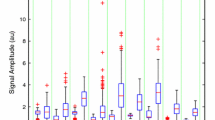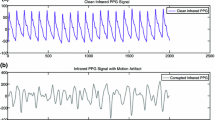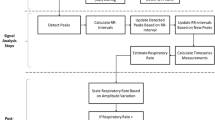Abstract
Photoplethysmography (PPG) signals can be used in clinical assessment such as heart rate (HR) estimations and extraction of arterial flow waveforms. Motion artefact and/or poor peripheral perfusion can contaminate the PPG during monitoring. A computational system is presented here to minimise these two intrinsic weaknesses of the PPG signals. Specifically, accelerometers are used to detect the presence of motion artefacts and an adaptive filter is employed to minimise induced errors. Zero-phase digital filtering is engaged to reduce inaccuracy on the PPG signals when measured from a poorly perfused periphery. In this system, a decision matrix adopts the appropriate technique to improve the PPG signal-to-noise ratio dynamically. Statistical analyses show promising results (maximum error < 7.63%) when computed HR is compared to corresponding estimates from the electrocardiogram. Hence, the results here suggest that this dual-mode approach has potential for use in relevant clinical measurements.




Similar content being viewed by others
References
Cook LB (2001) Extracting arterial flow waveforms from pulse oximeter waveforms apparatus. Anaesthesia 56:551–555
Foo JYA, Wilson SJ, Williams G, Harris M, Cooper D (2004) Motion artefact reduction of the photoplethysmographic signal in pulse transit time measurement. Aust Phys Eng Sci Med 27:165–173
Gustafsson F (1996) Determining the initial states in forward-backward filtering. IEEE Trans Signal Process 44:988–992
Hayes MJ, Smith PR (2001) A new method for pulse oximetry possessing inherent insensitivity to artifact. IEEE Trans Biomed Eng 48:452–461
Kepski R, Buchner T, Cytowski J, Malecka L, Walczak F (2001) Adaptive filtering in exercise high resolution ECG as applied to the hypertrophic cardiomyopathy. Pacing Clin Electrophysiol 24:1216–1223
Kyriacou PA, Powell S, Langford RM, Jones DP (2002) Investigation of oesophageal photoplethysmographic signals and blood oxygen saturation measurements in cardiothoracic surgery patients. Physiol Meas 23:533–545
Lindberg L-G, Ugnell H, Oberg PA (1992) Monitoring of respiratory and heart rates using a fibre-optic sensor. Med Biol Eng Comput 30:533–537
Luinge HJ, Veltink PH (2005) Measuring orientation of human body segments using miniature gyroscopes and accelerometers. Med Biol Eng Comput 43:273–282
Widrow B, Glover JR, McCool JM, Kaunitz J, Williams CS, Hearn RH, Zeidler JR, Dong E, Goodlin RC (1975) Adaptive noise cancelling: principles and applications. Proc IEEE 63:1692–1716
Author information
Authors and Affiliations
Corresponding author
Rights and permissions
About this article
Cite this article
Foo, J.Y.A., Wilson, S.J. A computational system to optimise noise rejection in photoplethysmography signals during motion or poor perfusion states. Med Bio Eng Comput 44, 140–145 (2006). https://doi.org/10.1007/s11517-005-0008-y
Received:
Accepted:
Published:
Issue Date:
DOI: https://doi.org/10.1007/s11517-005-0008-y




